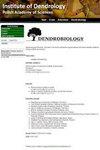Litterfall production and leaf area index in a virgin European beech (Fagus sylvatica L.) – Silver fir (Abies alba Mill.) forest
IF 1.8
4区 农林科学
Q2 FORESTRY
引用次数: 8
Abstract
Because of their role in carbon and nutrient exchange, litterfall and leaf area have been increasingly studied in the last few decades. However, most existing information comes from managed forests, while comparable data for virgin forests is scarce. To address this scarcity, we investigated a mixed beech – silver fir virgin forest located in the Southern Carpathian Mountains, using 78 litter traps to measure the annual litterfall production, litter composition and leaf area index (LAI). The LAI was calculated in two ways: directly, by using litter traps, and indirectly, based on hemispherical photographs. Furthermore, we investigated the influence of different stand and environmental characteristics on litter production, total foliar mass and LAIs. Annual litter productivity ranged from 1.8 to 8.3 t ha−1 with a mean of 3.5 t ha−1. Litter was composed mainly of beech leaves (66%) along with a lower percentage of silver fir needles (16%). The total foliar dry mass (sum of beech leaves and silver fir needles) increased significantly with the proportion of beeches and decreased with the median stand age. The LAI determined by using litter traps had a mean value of 5.06 m2 m−2, ranging from 3.52 to 8.22, and was characterised by a higher variability than the LAI estimated indirectly using the hemispherical approach (which had a mean value of 3.65 and a range of 2.30–5.28). The two indices did not correlate with each other. We found no significant relation between the LAIs and any stand or environmental variables. We conclude that in the more complex forests, such as the virgin beech – silver fir mixed forest we studied, annual foliar dry mass is more closely related to stand characteristics than is LAI. We also note significant limitations of both LAI estimation methods, which indicate that a more elaborate approach to estimating原始欧洲山毛榉(Fagus sylvatica L.) -银杉(Abies alba Mill.)森林凋落物产量和叶面积指数
由于凋落物和叶面积在碳和养分交换中的作用,近几十年来人们对它们的研究越来越多。然而,大多数现有资料来自管理森林,而原始森林的可比数据很少。为了解决这一稀缺性问题,我们研究了位于喀尔巴阡山脉南部的山毛榉-银杉混合原生林,使用78个凋落物陷阱测量了年凋落物产量、凋落物组成和叶面积指数(LAI)。LAI的计算有两种方式:直接的,通过使用凋落物陷阱,间接的,基于半球照片。此外,我们还研究了不同林分和环境特征对凋落物产量、总叶质量和lai的影响。年凋落物产出量为1.8 ~ 8.3 t ha - 1,平均值为3.5 t ha - 1。凋落物以山毛榉叶为主(66%),银冷杉针叶比例较低(16%)。叶面总干质量(山毛榉叶与银杉针叶之和)随山毛榉比例的增加而显著增加,随林龄的增加而显著降低。利用凋落物捕集器测定的LAI均值为5.06 m2 m−2,范围为3.52 ~ 8.22,其变异性高于采用半球形方法间接估算的LAI(平均值为3.65,范围为2.30 ~ 5.28)。这两个指数没有相互关联。结果表明,林分和环境变量对lai的影响不显著。结果表明,在较为复杂的森林中,如原始山毛榉-银杉混交林,年叶干质量与林分特征的关系比LAI更密切。我们还注意到两种LAI估计方法的显著局限性,这表明需要更详细的估计方法
本文章由计算机程序翻译,如有差异,请以英文原文为准。
求助全文
约1分钟内获得全文
求助全文
来源期刊

Dendrobiology
农林科学-林学
CiteScore
2.20
自引率
11.10%
发文量
17
审稿时长
>12 weeks
期刊介绍:
Dendrobiology publishes original research articles and review articles related to the biology of trees and shrubs.
 求助内容:
求助内容: 应助结果提醒方式:
应助结果提醒方式:


